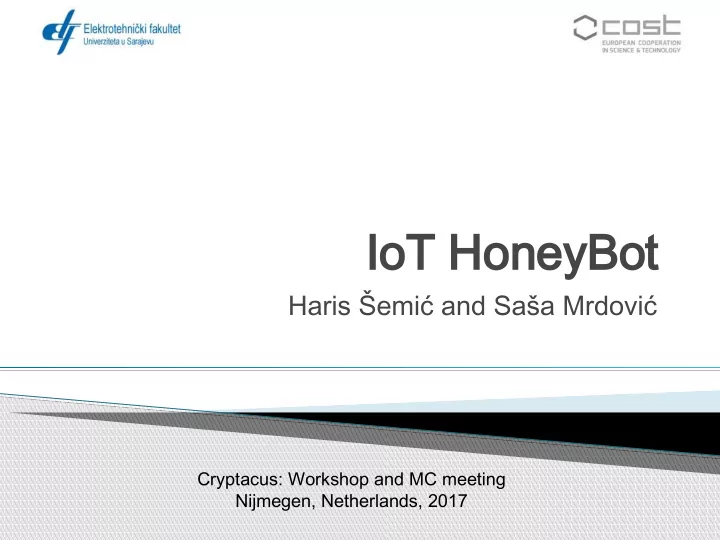

Io IoT Ho T Hone neyBot yBot Haris Šemić and Saša Mrdović Cryptacus: Workshop and MC meeting Nijmegen, Netherlands, 2017
Honeypots Honeypots Emulation of a network resource Built to be discovered, attacked and compromised Data collection with goal to: ◦ Prevent/detect future attacks ◦ Implement new or adapt existing security controls IoT HoneyBot
Internet Intern et of T f Thing hings Billions of special-purpose devices connected to the Internet Automatization of all aspects of modern life Remote control of IoT devices using distant network nodes 30+ billion IoT devices expected by year 2020 IoT HoneyBot
IoT b IoT botn tnets ts Client-server botnets ◦ Eg. Mirai, IoT Reaper ◦ Notable attacks: Krebs on Security 620 Gbs DDoS attack in 2016, Dyn DDoS attack Peer to peer botnets ◦ Eg. Hajime ◦ At the moment not malicious IoT HoneyBot
Current system Current system IoT HoneyBot
Front-end ont-end Manual component ◦ Handles manual attacks ◦ Requires complementary configuration file ◦ Emulates the look and feel of a real IoT device Mirai component ◦ Handles mirai attacks ◦ Emulates specific responses which are expected by Mirai IoT HoneyBot
Back-en Back end IoT HoneyBot
Can multi-component design be applied for large- scale malware observation and research? IoT HoneyBot
The e Id Idea ea Mass-deployment of IoT honeypots Malware research Anti-botnet Propagation observation Employment of machine learning to handle new types of attacks Encrypted communication IoT HoneyBot
IoT HoneyBot
Sing Single honeybot node le honeybot node Implemented using Node.js Interacts with malicious traffic and supports: ◦ Telnet protocol ◦ SSH protocol ◦ HTTP, HTTPS Interaction with central server includes: ◦ Receiving configuration ◦ Login attempt validation ◦ Delivering and receiving encrypted data IoT HoneyBot
Central server Central server Stores and reports captured data: ◦ One file for each unique IP address ◦ Each file contains a history of attacks from any specific source Contains: ◦ Username-password combinations ◦ Database of known attacks ◦ Emulation configurations Implements machine learning to handle new types of attacks Threaded implementation IoT HoneyBot
IoT HoneyBot
Implementation challenges IoT HoneyBot
1. Mass-deployment 1. Mass-deployment Hundreds (thousands!) of honeypot nodes present two challenges: ◦ Deployment Physical location of each machine How many VMs on a single machine ◦ Administration Monitoring each node Data reporting IoT HoneyBot
2. Machine learning algorith 2. Machine learning alg rithm IoT HoneyBot
3. Singl 3. Si gle point of failure e point of failure A single central server with static IP address and domain can easily be blocked and cut off Some resilience techniques from existing botnets need to be borrowed: ◦ Fast-flux technique (multiple IPs for a single domain name) ◦ Domain generation algorithm (continuous generation of random domains) IoT HoneyBot
Thank you IoT HoneyBot
Recommend
More recommend